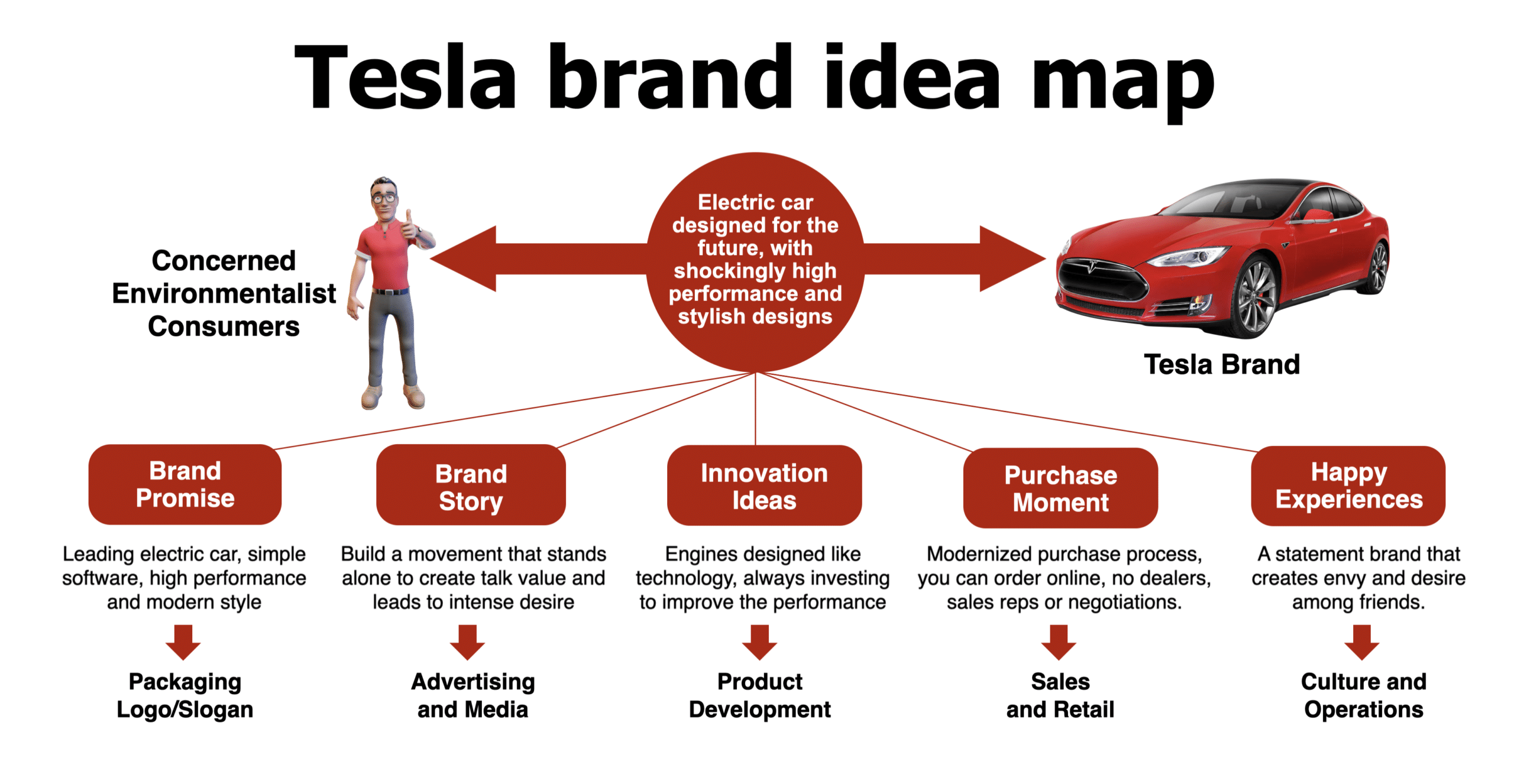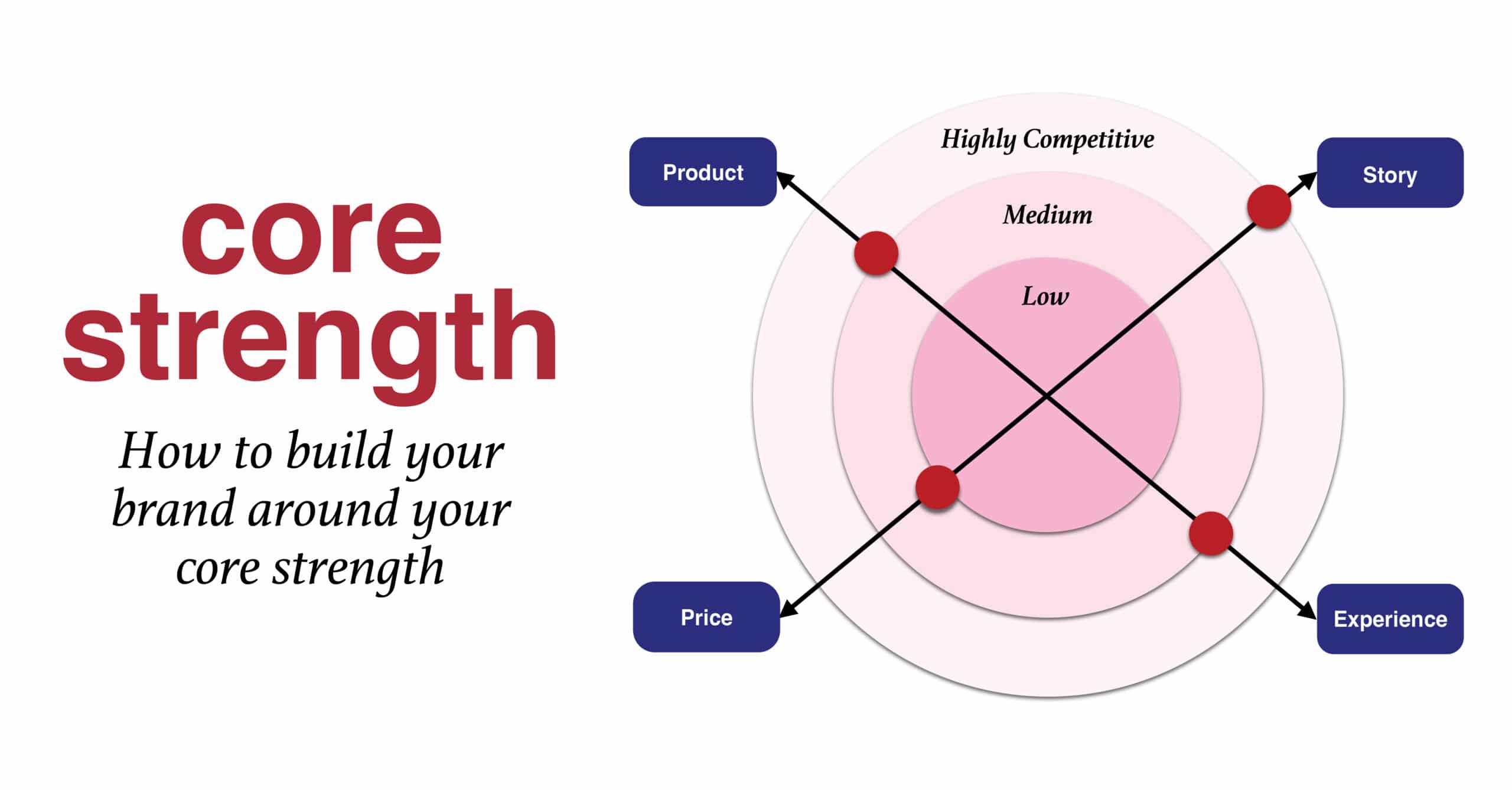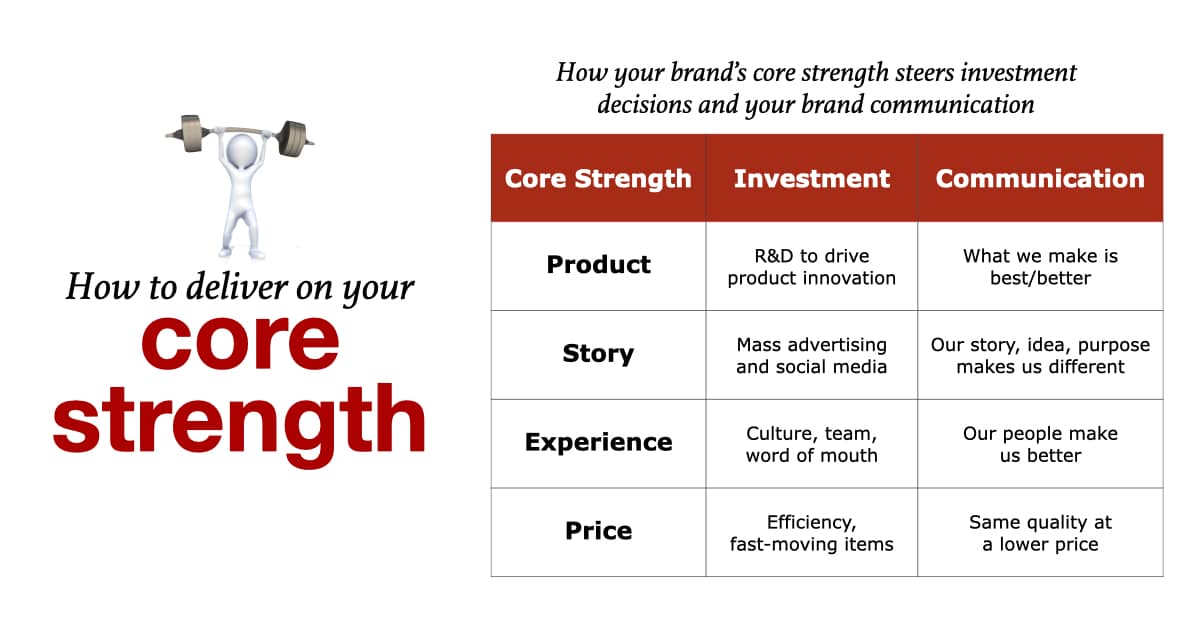Too many brands try to have a few core strengths. This clutters up their brand positioning, so they end up with no real perceived strength that stands out. Our core strength model forces you to select one of four possible options for you to win with. Is it the product, brand story, experience, or price?
For many marketers, their immediate response is an urge to pick two or three core strengths. They believe the myth that having many strengths makes your brand stronger. Focus will make your brand stronger. And, when you build your marketing plan, you will know what you need to do.
To illustrate, click on the diagram to zoom in.
Brand Strategy
Our Strategic Thinkbox looks at core strength, the consumer bond you have, the competitive situation you face. I’ve always believed that strategic thinkers see questions before they see solutions. Ever hear someone say, “That’s a good question?”
It means someone just asked an interruptive question, designed to slow everyone’s thinking, so they reflect and plan before they act.
The strategic thinking side of marketing is logical and helps you map out a range of decision trees that intersect, by imagining how events will play out in the future.
With this in mind, I created the Strategic ThinkBox, that asks questions that set up your strategy. We look at four strategic questions to force you to look at:
- Core strength
- Consumer Strategy
- Competitive Strategy
- Business Situation
Your brand's core strength
Here is the game I have created to help choose your brand’s core strength.
- Use the diagram above, start with four chips. You must place one chip where you believe you have the highest competitive advantage to win.
- Then, put two chips at the medium level that backs up and supports the core strength.
- Finally, the game forces one chip to be at the low end. This is a throwaway weakness that will not be part of the strategy.
It is a great game to try with your team. It sets up a great debate among your team members.
Four types of brands
- Product-led brands should invest in R&D while communicating the consumer benefits, features, and claims for what makes the brand better.
- Story-led brands need to invest in advertising, with the story, idea, or brand purpose communicating what makes the brand different.
- Experience-led brands have to invest in creating a culture with strong operations. Build your brand communications around the idea that, “Our great people make the difference in creating amazing experiences.”
- Price-led brands must invest in operational efficiency. And, the brand communications explains how “We are smarter and able to deliver the same quality at a lower cost.”
As you figure out your brand’s core strength, it helps focus what you should be investing in and what your main communication message should be. Product led brands should invest in R&D and communicate how you are better. Story led brands should invest in advertising to communicate how they are different. Experience led brands should invest in building the culture and communicating how your people make you better. Price led brands must focus on efficiency and communicate how you can offer the same quality at a lower price. To illustrate, click to zoom in.
Product-led brands
When you are a Product-led brand, you must own the “better” position in your category. Invest heavily in continuous innovation to maintain category leadership in new technology, superiority claims, and the latest product formats. These brands must aggressively defend against any challengers. Leverage product-focused mass communication, directly highlighting the product’s superiority and comparing product features to those of other competitors.
Within your mass communications, layer in “how the product is built” into the brand story. This reinforces your brand’s product point of difference. Use online product reviews sites, bloggers, and expert influencers to reach the trend influencer consumers on all new product innovations. When selling to consumers, use a rational approach, highlighting technical features, new claims, and the logic behind the purchase decision. Product-led struggle to build and drive an emotional connection with consumers.
As the brand matures, it must find ways to layer a brand idea on top of the product to inspire the consumer to connect on a deeper level. Fantastic product-led brands include Samsung, Tide, Five Guys, or Ruth’s Chris. These products manages to create a high degree of consumer loyalty.
To illustrate, click on the diagram to zoom in.
Rolex
Rolex is a product-led brand that has done an incredible job of building emotion into their brand. Consider Rolex’s language choices.
- “Crafted from the finest raw materials.”
- “Assembled with scrupulous attention to detail.”
This conveys the brand’s commitment to product design and production, ensuring the Rolex brand epitomizes prestige and success. Rolex uses beautiful writing for a product-led brand. Their brand communications are subtle in tone, sticking to high-profile, refined sponsorships events like Wimbledon tennis and the Master’s golf.

Story-led brands
When the brand story is your brand’s key strength, focus the strategy on ways to be different. Invest in gathering consumer insights, equal to how a product-led brand spends on patents. To tell the brand story, use emotional brand communication that connects the most motivated consumers with the brand idea. Line up everything—brand story, product, and experience—under that brand idea.
Story-led brands should cultivate a community of core “brand lovers.” Get them to talk about the brand story and influence others within their network. Use a soft sell approach. Never bring the price to the forefront, as it can take away from the idea.
To illustrate, click on the diagram to zoom in.
Some of the more successful story-led brands include Apple, Nike, Virgin, and Dove. These are some of the most beloved brands of our generation.
Tesla
Most recently, the Tesla brand has borrowed a lot of Apple’s core principles. Tesla builds everything around the story of “Tesla will save the planet with innovation.” Tesla uses many innovative approaches, including the visionary charm of their leader, Elon Musk, who appears to be the new generation’s answer to Steve Jobs. Musk has become a spokesperson for a generation of consumers who want to save the planet. Tesla’s environmental activities around the world go far beyond expectations.
A great example of the mystique of the Tesla brand is how quickly it mobilized to help out Puerto Rico after a hurricane knocked out the island’s power in 2017. Even as various levels of government were arguing over who should do what, Tesla brought 700 solar panels to the Hospital del Niño, where the batteries restored service to 3,000 patients who needed constant care.
In 2016, Tesla topped Consumer Reports’ Annual Owner Satisfaction Survey at an incredible 91% rating, 5% higher than a Porsche, and 15% higher than Toyota and Honda. The same year, over 400,000 consumers put down $1,000 for a specific Tesla model that did not yet exist. On top of that, these new cars would not roll off the factory lines for another three to four years. Consumers see Tesla as more than just a vehicle, but rather an investment in a movement for the future. Even as Tesla struggles to meet demand, the company keeps adding to its brand story.

Beloved Brands Marketing Training
To view, use the arrows to see our Beloved Brands Marketing Training program brochure.
It's time to elevate your marketing team's performance with our Beloved Brands Marketing Training program.
Our marketing training makes your marketers smarter with brand analytics, strategic thinking, brand positioning, brand plans, and marketing execution.
Consumer experience-led brands
When the consumer experience is your brand’s lead strength, the strategy and organization should focus on creating a link between your culture and your brand. Your people are your product. Use your brand purpose (“Why you do what you do”) and brand values to inspire and guide the service behaviors of your people. Then build a culture and organization with the right people who can deliver incredible experiences.
Experience-led brands need to be patient. The quick mass media approach might not be as fast or efficient as the product-led or idea-led brands. The most effective communication tools for consumer experience-led brands include word of mouth. Add in earned media, social media, online consumer reviews, the voice of key influencers, and consumer testimonials. These brands can make a mistake if they put too much emphasis on price. This can diminish the perceived consumer experience.
Some of the best consumer experience-led brands include Ritz-Carlton, Emirates Airline, Airbnb, Amazon, Netflix, and Starbucks.
To illustrate, click on the diagram to zoom in.
Airbnb
Airbnb does a fantastic job of delivering a fabulous consumer experience. They deliver on their brand idea of “Don’t just go there. Live there.” Airbnb takes all the hard work travelers have been doing, and they put it right in front of the consumer. You can sort by city, even down to the neighborhood. Sort by the type of residence, specify a few needs (Wi-Fi, pet-friendly), then enter your price range.
With most of the rentals, you can see 15-20 photos to give you an idea of the space. You make your choice. Select the dates. Provide government ID to confirm your identity. And then your offer goes to the owner. Moments later, or when they wake up, they reply saying yes. There is a bit of hunting that goes on. But it adds a thrill to the travel experience. Overall, it is so much easier than everything the traveler, looking to rent a house or flat, has done in the past.
Airbnb has nailed the creation of the brand idea of “Don’t just go there. Live there.” Airbnb’s data says 86% of the consumers who use Airbnb pick the platform because they want to live more like a local. That insight of living rather than visiting inspired the brand’s latest and largest marketing campaign, “Live There.”

Price-led Brands
When price is your brand’s lead strength, you must focus on ways to drive efficiency. This ensures the lowest possible cost structure. These brands should invest in the fundamentals around production and sourcing to maintain a low-cost competitive advantage. They must use the brand’s power to win negotiations.
These businesses have to drive cash flow with fast moving items that deliver high turns and high volume to compensate for their lower prices. The winning price-led brands need to own the low price positioning by fiercely attacking any potential competitive challenges.
Regarding advertising, the smartest message explains your secret for how you are smarter than your competitors, and you can offer lower prices. Also, use call-to-action marketing to keep high sales turns.
There is a big difference between low-price and cheap. Price-driven consumers are not always willing to sacrifice product quality. They expect lower prices but still want robust performance standards. However, these price-driven consumers have shown they are willing to accept a lower-quality consumer experience. Since price is such a rational reason to buy, consumers do struggle to love the price-led brands.
To illustrate, click on the diagram to zoom in.
Walmart
Walmart is one of the best price-led brands. No one is more efficient at brick-and-mortar retail. While many department store competitors sell through their inventory in 100 to 125 days, Walmart sells through its inventory in 29 days – one day before they even have to pay for it.
Walmart successfully beat century-old retailers, such as Sears, Kmart, and JC Penney. It also destroyed the “mom and pop” shops of small towns across America. The company’s outward sales pitch is price, but efficiency drives its internal culture, and their real secret is to focus on fast-moving items. Walmart uses its brand power to bully suppliers, who give in just to be part of Walmart’s high sales volumes.
Now Walmart faces its toughest battle with Amazon, in what some are calling, “Clicks versus Bricks,” as online has disrupted traditional retail. While Walmart has struggled to create an emotional bond with consumers, one significant advantage for Amazon is its reputation as one of the most beloved brands on the planet. Amazon uses smart pricing with extraordinary customer service to delight its consumer base. Walmart will be in the most desperate battle of its life.

How your investment stance lines up to your core strength
We start to see one of the significant benefits of finding your core strength is that you can focus your investments in the right areas. When you are a product-led brand, you need to invest in product innovation with a robust R&D team. When you are brand story-led, you need to make sure your advertising, PR, social media is delivering. For experience-led brands, it’s about the culture, with values, service behaviors, and motivation fo your people. Price-led brands are not cheaper; they have lower costs. You need to focus on efficiency through high volume, fast-moving items, and lower costs.
To illustrate, click on the diagram to zoom in.

















